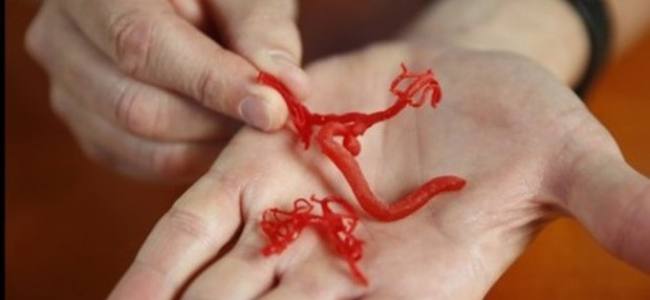
Artificial blood vessels created with a 3D bio-printer tecnology
Can we print bodypart? Yes, now we can do it. Thanks to a new international research
3D Printed organs come a step closer
Until now a major barrier to them moving from printing tiny sheets of tissue to entire 3D organs is that they hadn’t figured out how to develop the blood vessels that provide cells with nutrients and oxygen, and allow them to excrete waste.
This essential process is called “vascularisation” and is necessary if researchers are to ever prevent cells from dying so they can grow large, transplantable organs.
But in a major medical breakthrough, researchers from Sydney and Harvard universities have managed to 3D bio-print capillaries, the tiny channels that allow vascularisation to take place so that cells can sustain themselves and survive.
Using a high-tech “bio-printer”, the researchers fabricated tiny, interconnected fibres to serve as the mould for the artificial blood vessels.
They then covered the 3D printed structure with a cell-rich protein-based material, which was solidified by shining light on it.
Lastly they removed the bio-printed fibres to leave behind a network of tiny capillaries coated with human endothelial cells, which formed stable blood capillaries in less than a week.
Biomedical engineer and a leader of the research, the University of Sydney’s Dr Luiz Bertassoni, said printing organs may still be a couple of decades away, but this was a “great step” towards achieving that goal.
“We have shown that we can print these capillaries, we have shown they are functional, that they mature to form capillaries and that we can tailor make them to the sizes and structures we need,” he said.
“Tissue engineering to make simpler tissues has been a reality for a number of years and through what we have been able to achieve, we can start talking about larger, more complex tissues that are able to survive longer.”
While the bulk of the research was carried out at Harvard, Bertassoni said a lab had recently been established at the University of Sydney so his work could continue in Australia.
Since the findings were published in the journal of the Royal Society of Chemistry on Thursday, Bertassoni said he had been contacted by a few patients who wanted to know if the technology meant organs could now be “printed”.
He stressed that was not the case, but said what his team had found was “game-changing”.
“Thousands of people die each year due to a lack of organs for transplantation,” Bertassoni said.
“Many more are subjected to the surgical removal of tissues and organs due to cancer, or they’re involved in accidents with large fractures and injuries.
“While printing organs may be a couple of decades away, I also wouldn’t be surprised if I was wrong about that because this type of engineering is moving so rapidly.
“I would so love to be wrong.”


